Gene:
. I agree with you wholeheartedly. I was disappointed to see people carry my work to silly extremes. One wanted to develop one of my charts for a specific RI (he couldn't solve my formulas because they are implicit - I did the whole thing with a slide rule!). For colored stones it is less important than for diamonds because light return is not the most important thing. Here is the preface I wrote for reprints I made via Xerox in 1987:
. "There has been much correspondence from many countries, all favorable; however there has been a tendency to over-rate the value of this work. Before gem-cutting, my hobby was mathematics and I worked in true research; it was automatic that I would approach faceting in this academic way*.
. I am satisfied that I proved WHY the well-known 'best' slopes are best and that there are others which have probably been 'discovered' often. We contributed nothing new ... just showed WHY!
. We now cut stones only for profit and focus on those factors which most affect salability ...
... GOOD NATERIAL - color & clarity count most
... GOOD POLISH ---- important in brilliance
... FLAT FACETS ----- important to scintillation
We use mostly traditional cuts and facet slopes."
* A recent hobby interest in computers produced many interesting results. When shown to a British expert he said, in essence, "So what?"
. Al Fargo, the faceting man at Raytech, visited a club in Texas who were examining facets by magnification and missed that that they were not flat! They were using 'Ultralaps' = thin mylar discs which bulged-up slightly at the leading edge.
. Glenn Vargas pointed-out that Brazilian stones then had all facets rounded on the same edge because they flop them down onto the lap (hand-held jamb-peg method then).
. On a TV marketing show you will see the round-off edges of gems as they revolve in the light.
. A few years ago I visited a faceter's club. One admired local 'expert' showed a faceter head he made displaying the tilt angle to 3 decimal places; it varied as you walked near it! Nothing on a faceting machine can reproduce that accurately! Anton Vasiliev, who cuts commercially, agrees with me that anything beyond one decimal place is absurd.
. My computer interest produced a ray tracing program (in BASIC!) in 1986, which I am told was the first. Garry played with it at my home in 2000. I gave copies to the Russians and later asked them to include my multiple ray function in theirs (DiamCalc), which you will see in some of my illustrations here - a fun tool used by few.
. You are right about the crystal orientation and direction of best color - one of my favorite questions. Beryl & tourmaline generally have best color crosswise to the length of their prismatic crystals - hence the long step-cuts. Corundum generally has best color looking down the c-axis, so they are generally but round; however, synthetic boules (in the 70's) were seeded on a bias and split lengthwise so a rectangular-cut ruby or sapphire was generally synthetic then.
. Garry: this is one of the significant differences from diamond-cutting.
. I agree with you wholeheartedly. I was disappointed to see people carry my work to silly extremes. One wanted to develop one of my charts for a specific RI (he couldn't solve my formulas because they are implicit - I did the whole thing with a slide rule!). For colored stones it is less important than for diamonds because light return is not the most important thing. Here is the preface I wrote for reprints I made via Xerox in 1987:
. "There has been much correspondence from many countries, all favorable; however there has been a tendency to over-rate the value of this work. Before gem-cutting, my hobby was mathematics and I worked in true research; it was automatic that I would approach faceting in this academic way*.
. I am satisfied that I proved WHY the well-known 'best' slopes are best and that there are others which have probably been 'discovered' often. We contributed nothing new ... just showed WHY!
. We now cut stones only for profit and focus on those factors which most affect salability ...
... GOOD NATERIAL - color & clarity count most
... GOOD POLISH ---- important in brilliance
... FLAT FACETS ----- important to scintillation
We use mostly traditional cuts and facet slopes."
* A recent hobby interest in computers produced many interesting results. When shown to a British expert he said, in essence, "So what?"
. Al Fargo, the faceting man at Raytech, visited a club in Texas who were examining facets by magnification and missed that that they were not flat! They were using 'Ultralaps' = thin mylar discs which bulged-up slightly at the leading edge.
. Glenn Vargas pointed-out that Brazilian stones then had all facets rounded on the same edge because they flop them down onto the lap (hand-held jamb-peg method then).
. On a TV marketing show you will see the round-off edges of gems as they revolve in the light.
. A few years ago I visited a faceter's club. One admired local 'expert' showed a faceter head he made displaying the tilt angle to 3 decimal places; it varied as you walked near it! Nothing on a faceting machine can reproduce that accurately! Anton Vasiliev, who cuts commercially, agrees with me that anything beyond one decimal place is absurd.
. My computer interest produced a ray tracing program (in BASIC!) in 1986, which I am told was the first. Garry played with it at my home in 2000. I gave copies to the Russians and later asked them to include my multiple ray function in theirs (DiamCalc), which you will see in some of my illustrations here - a fun tool used by few.
. You are right about the crystal orientation and direction of best color - one of my favorite questions. Beryl & tourmaline generally have best color crosswise to the length of their prismatic crystals - hence the long step-cuts. Corundum generally has best color looking down the c-axis, so they are generally but round; however, synthetic boules (in the 70's) were seeded on a bias and split lengthwise so a rectangular-cut ruby or sapphire was generally synthetic then.
. Garry: this is one of the significant differences from diamond-cutting.

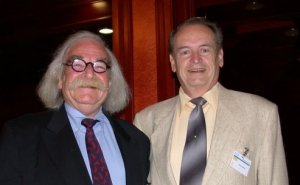
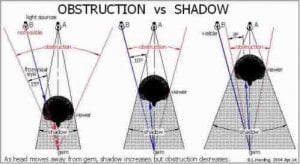
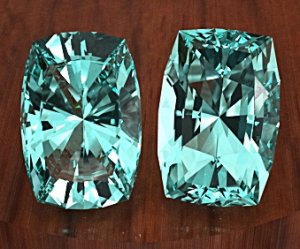
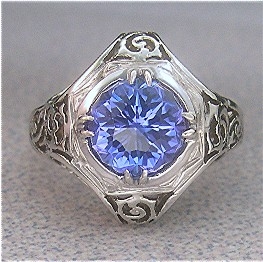
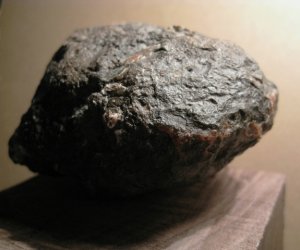
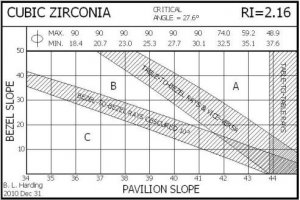
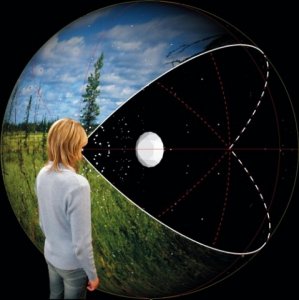
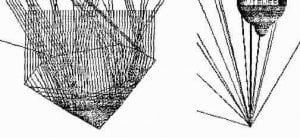
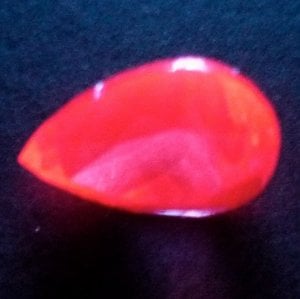



300x240.png)